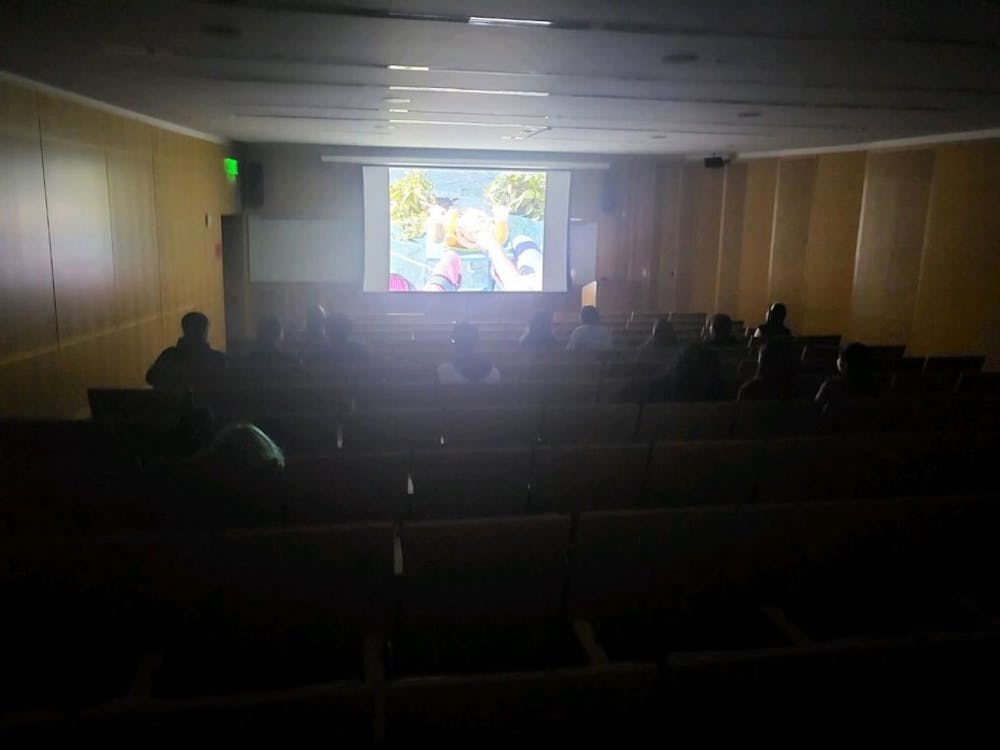It was a cool Sunday night when two other dames and I walked into the darkened theater. Our sneakers padding along the carpeted floor made no sound, but heads turned to watch our entrance. They knew we were looking for trouble. What kind, you ask?
Murder.
Not real murder of course, strictly the cinematic variety. I was attending the Hopkins Film Society weekend Whodunnit film screenings. The screenings were free and took place in Gilman 50. They showed murder mystery movies as old as 1954 and as new as 2019.
On the third and final night, the members showed Dial M for Murder (1954) and Clue (1985). Between every night’s two showings, they also screened the winners of their short film competition.
I wasn’t expecting there to be much energy on a Sunday night, a time when most people were hunkered down in Brody Learning Commons, scrambling to finish (or start) assignments due the next day. But when I walked into the (admittedly mostly empty) theater during the last few minutes of Dial M for Murder, I was pleased to find how warm and welcoming it was.
People sat in little groups or alone, completely engaged in the movie. I had no context for what was going on, but the audience’s laughs and exclamations caught me up pretty quickly. Within a minute of sitting down, I was laughing along with everybody else.
Since the pandemic began, I’ve only been to a single deserted movie showing at a theater. I’d forgotten what it was like to watch a movie with a bunch of people you don’t know. There’s something so comforting and communal about it. In the couple of hours you sit together, you know your minds are all in the same place. It’s one of the few places where total strangers can laugh and cry together without exchanging a word.
The short films were shown right after the end of the first movie. At the same time, a couple of the Film Society members made popcorn in a real popcorn machine! As a member of the esteemed News-Letter, I felt it was my utmost responsibility to taste test the food offerings and report my findings to the public... It was pretty good popcorn.
The first short film was called Hétérotopie - Le voyage est un miroir. Directed by Gabriele Vizzi, the film shows short scenes from a trip to Iran. It showcases the daily life of Iranian people and questions what it meant to be a visitor to a place. It features stunning cinematography that shows the beauty of Iran, a perspective that is not often offered to us in America.
The second short film was called Jardins Paradise. It was directed by Yza Nouiga and depicts people trying to claim a little vacation for themselves amid the lockdown of the pandemic.
The third short film was Us. It’s an animated film directed by Nelson Fernandes that shows violent and warlike imagery of people surviving and killing. The art style is beautiful, a static-like and foggy film partially obscuring its events, the effect created by using stop-motion animation on sheets of tracing paper.
The fourth short film was Eureka. It was directed by Milda Chu and shows a Chinese prostitute in the American Old West struggling with sexual assault and emotional abuse from the head of the brothel and racism from the townspeople. It’s haunting and disturbing but spectacularly shot.
Then they screened Clue, the last showing of the night. Clue is a whodunnit mystery based on the board game of the same name. It’s got everything you’d want from a movie adaptation of the classic game, following several members of a dinner party as they try to solve the murder of Mr. Boddy and more people die along the way.
The cast of characters is entertaining and familiar. There’s the butler Wadsworth, a sketchy man who always seems to know more than he lets on. There’s Mrs. Peacock, a silly rich old woman with friends in high places. There’s Mrs. White, a widow with multiple husbands dead of suspicious causes. Professor Plum, a pervy, disgraced psychiatrist. Colonel Mustard, a boisterous army man with little brain. Mr. Green, a nervous closeted gay man with government ties. And Miss Scarlet, a sassy woman who runs an escort service.
Which one could be the murderer?
Imagine the most cliche, quintessential murder mystery at a dinner party and you’ll know exactly what kind of movie Clue is. It takes place in a mysterious manor on a dark and stormy night. Everyone is under suspicion of murder.
The movie’s cliche qualities are its greatest strength. It knows exactly what kind of movie it is, and it delivers on every point. It gives the audience what it wants. It’s also hilarious and doesn’t take itself too seriously.
The movie’s twist? It has three different endings! When it was originally released in theaters, a different ending would be sent to each cinema. It was a lot of fun to watch all three endings in succession in the theater, some more outrageous than others.
Halfway through the third and final ending, we ended up getting kicked out of the theater by an employee, as it was past 11 p.m. We left the theater with a mystery still unsolved, a fitting ending for a great event.





